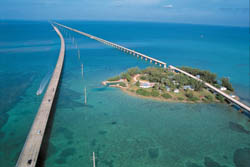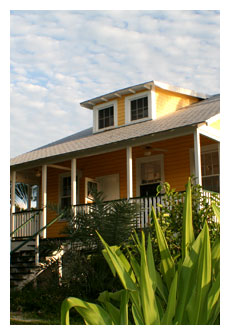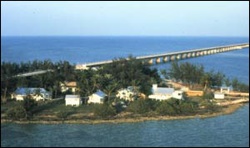Pigeon Key: A Tiny Island with an Enormous History
MARATHON, Florida Keys — Just over two miles west of Marathon, nestled beneath what is now called the Old Seven Mile Bridge, lies the historical treasure known as Pigeon Key. In the early 1900s, the five-acre island served as a base camp for workers during construction of the original Seven Mile Bridge, the awe-inspiring centerpiece of Henry Flagler's Key West Extension of the Florida East Coast Railroad.
Visitors shouldn't pass up the chance to explore Pigeon Key, which, despite its tiny size, played an enormous role in Keys history. Listed on the National Register of Historic Places, today it houses century-old buildings and a museum chronicling the construction of the Key West Extension, commonly called the Oversea Railway because its track stretched more than 100 miles out into open water.
The first Oversea Railway train rolled from the Florida mainland through the Florida Keys to Key West in January 1912, connecting the Keys to the mainland and each other for the first time.
A celebration to honor the historic railroad, lauded as the most unique railway in the world upon its completion, has begun in the Keys. Planned elements include history tours showcasing Flagler sites, bicycling expeditions, educational presentations and explorations of Pigeon Key. Events are to culminate Jan. 22, 2012, the 100th anniversary of the inaugural train's arrival in Key West.
The Oversea Railway's bridges and viaducts linking the islands of the Keys, including the landmark seven-mile span at Marathon, were regarded as an engineering marvel.
More than 400 workers lived in the railroad village on Pigeon Key, which had a post office, commissary and one-room school, during the Seven Mile Bridge's construction from 1908 to 1912. Following its completion, maintenance crews continued living on the island.
A hurricane destroyed the railway in 1935, and a state highway was built to replace it. Pigeon Key then became headquarters to the Florida Road and Toll Bridge District, whose crews maintained the bridges from Jewfish Creek to Big Pine Key.
Starting in 1968, for two decades the island served as an environmental field station for international researchers studying tropical and subtropical marine and island ecologies with the University of Miami. In 1993, the not-for-profit Pigeon Key Foundation assumed stewardship of the island and began restoration efforts.
Under the foundation's tutelage, the tranquil, picturesque spot opened to visitors, providing them an opportunity to revisit Flagler's era. The railroad museum, located in one of the original 1909 buildings, features exhibits including maps, historic photos, models and a picture postcard collection of the unique line over water.
Visitors can spend the entire day on the island, exploring the fully restored turn-of-the-century buildings, soaking up subtropical sun on a picnic, snorkeling the tidal shoreline and absorbing the history of the early Florida Keys.
Pigeon Key also offers hands-on private educational programs for students from elementary school to post-graduate levels through its respected Pigeon Key Marine Science Camps during summer months. Participants enjoy workshops on marine mammals and reef fish, coral reef systems, invertebrates and hard and soft corals found in Florida/Caribbean waters. In addition, they can become scuba certified during a camp session.
Accessible by ferry from a visitor center at Knight's Key on the west end of Marathon, Pigeon Key also welcomes many visitors who walk or bike to it along a breathtakingly scenic portion of the Old Seven Mile Bridge, closed to vehicular traffic since 2007.
Guided ferry tours depart from Knight's Key daily at 10 a.m., 11:30 a.m., 1 p.m. and 2:30 p.m. Return trips from Pigeon Key depart at 10:30 a.m., 12 p.m., 1:30 p.m., 3 p.m. and 4 p.m. To reserve a seat on the ferry, call 305-743-5999. Reservations are not required but are suggested for holidays and weekends.
Cost for a day's admission to the island, including the ferry transportation and tour, is $11 for adults, $8.50 for children ages 5 to 13 and free for younger children.
Pigeon Key information: www.pigeonkey.net
Marathon visitor information: 1-800-262-7284 or www.fla-keys.com/marathon
Social: Facebook • Twitter • YouTube

The first Oversea Railway train rolled from the Florida mainland through the Florida Keys to Key West in January 1912, connecting the Keys to the mainland and each other for the first time.

In the early 1900s, the five-acre island served as a base camp for workers during construction of the original Seven Mile Bridge, the final installment of Henry Flagler’s Key West Extension of the Florida East Coast Railroad.

Visitors can spend the entire day on the island, enjoying activities or taking time to explore the fully restored turn-of-the-century buildings.

The tranquil, picturesque island is open to visitors to spend the day exploring the historic museums, soaking in sunshine, picnicking and enjoying the tropical breezes.

